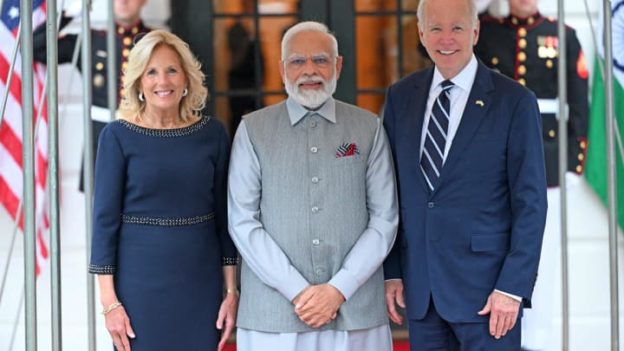The reality is that the opportunities for the U.S. and India to partner even more closely are abundant across nearly every sector, ultimately driving economic growth in both countries and around the world.
Prime Minister Narendra Modi’s first US state visit – the first state visit by an Indian Prime Minister since 2009 –is in the books, but there is still so much more to write in the pages of the US-India strategic partnership playbook.
The historic June state visit epitomized, as President Joe Biden said, why this will become the most defining partnership for the 21stcentury.Our countries are at an inflection point, where an even stronger strategic, win-win relationship can change the future of every citizen around the world.
The formalities of diplomacy have been well documented, from a grand guard of honor at the White House to an elaborate state dinner, to Prime Minister Modi’s historic feat of becoming the first Indian Prime Minister ever to address both chambers of the U.S. Congress twice, following his earlier address in 2016. The US-India Strategic Partnership Forum (USISPF) was also fortunate to have the Prime Minister accept our invitation to address a nearly 1,100-strong audience.
However, beyond the formalities of a state visit lie concrete next steps to further strengthen the U.S.-India partnership through policy changes in critical areas, such as innovation, energy, trade, defense, critical technology, education, and people-to-people connections.
On defence, for example, new partnerships will rapidly modernize security for a new era of threats that are rapidly happening online and/or enabled by emerging technologies. We need not look further than the Russia-Ukraine war to understand the importance of this, which has become the example of modern warfare, with cyber attacks tripling in Ukraine last year and even more continuing in 2023. The landmark agreement between General Electric and Hindustan Aeronautics Limited will make India only the fifth country in the world with the capability to manufacture jet engines. In the days following the state visit, the U.S. and India recently announced a new deal to have General Atomics MQ-9B High Altitude Long Endurance (HALE) Unmanned Aerial vehicles (UAV)(i.e., “MQ-9B drones”)assembled in India and shared between the Indian Army and Air Force. Also against the backdrop for the Prime Minister’s visit to Washington, the launch of the India-US Defense Acceleration Ecosystem will support and bring together defense startups in both countries for the development of mutually beneficial military innovations.
In the area of tech, many global geopolitical tensions – and opportunities – today lie in semiconductors and chips, which are the core bedrock for next-generation innovation. Over the past year, the world has witnessed a growing tit-for-tat competition between the US and China, with both countries enacting export controls, bans, and more. The relationship with China used to be a win-win one but over the past decade, it has become win-lose, with China allegedly participating in IP theft against US-patented technology. That said, the U.S. also can’t maintain its leadership position in tech without the help of others; we simply don’t have the capabilities needed to make the advanced chips we need. Fortunately, India has been doing its part to step naturally into this role. The Indian government has actively worked to boost manufacturing through incentives such as Make in India and the Production Linked Incentives initiatives. The message is clear: India, which has moved from its historical agrarian-based economy to a now services-based economy, has demonstrated its capability to manufacture high-end technology – and the US is taking notice. The US-India Semiconductor Supply Chain and Innovation Partnership will establish cooperation between U.S. and India semiconductor supply chains and promote commercial opportunities, research & development, and talent and skill development.
India is also increasing its manufacturing capabilities beyond tech. Consider solar panels. China currently dominates the global solar panel sector – but India has the potential to compete in a big way. In fact, one report found that India’s solar panel sector will likely reach self-sufficiency by 2026. As both the US and India look at their joint goals in renewable energy, and as India seeks to reduce dependence on fossil fuels and imports of Russian energy, working together once again just makes smart sense.
The reality is that the opportunities for the U.S. and India to partner even more closely are abundant across nearly every sector, ultimately driving economic growth in both countries and around the world.
The time to invest in India is now. With one of the largest skilled, educated, and English-speaking populations in the world, as well as a voluminous number of tech professionals, the tech synergy in particular between India and the U.S.is a natural one. This state visit underscored that the future is bright – but also how we need to act immediately to build a country-to-country relationship that will soon serve as the model for the rest of the world.
https://www.financialexpress.com/business/defence-pm-modis-us-visit-is-over-now-for-the-policy-outcomes-3200832/





